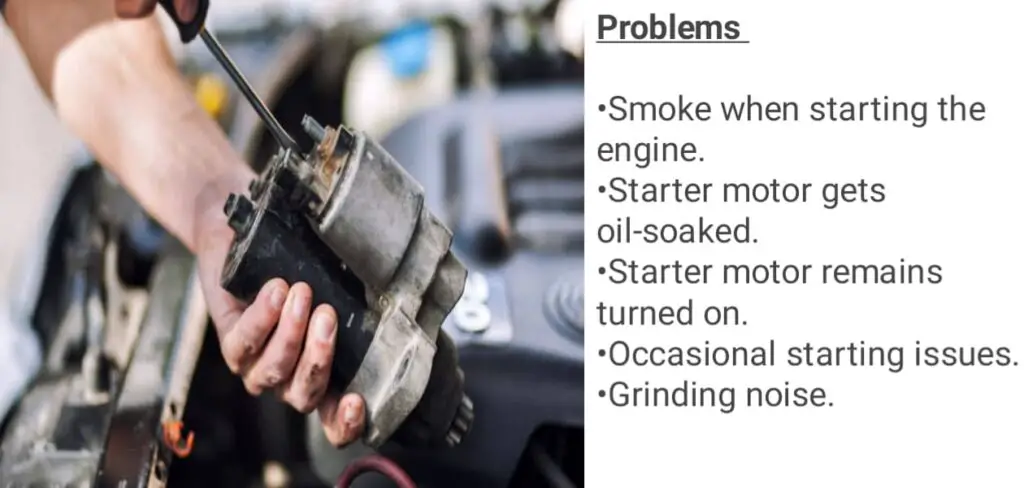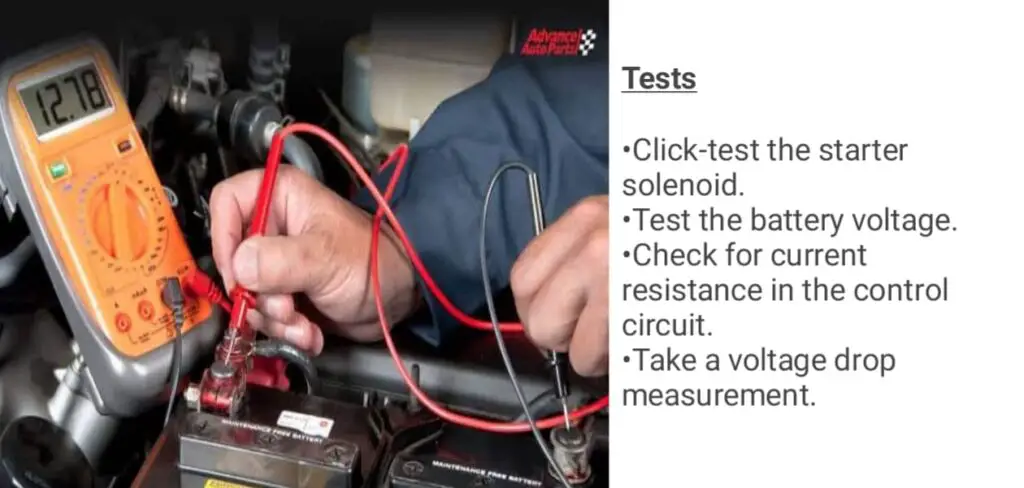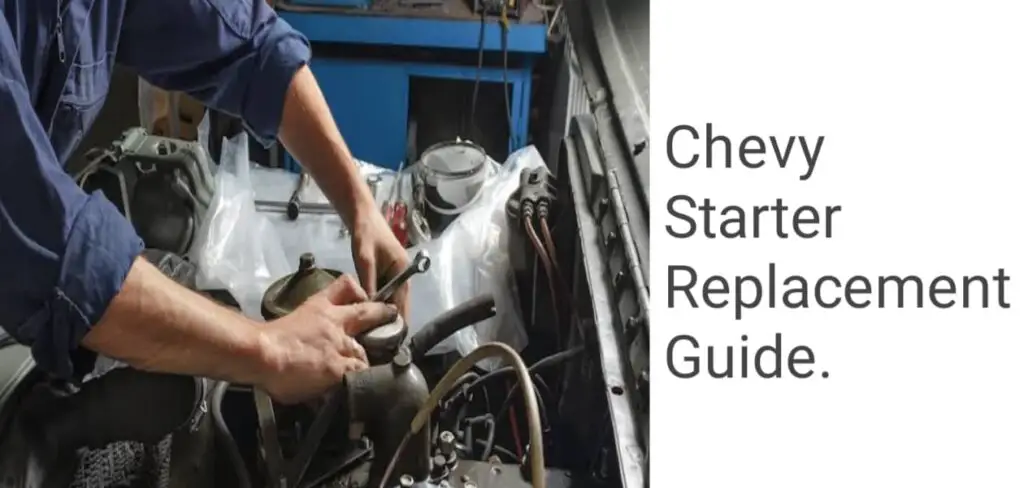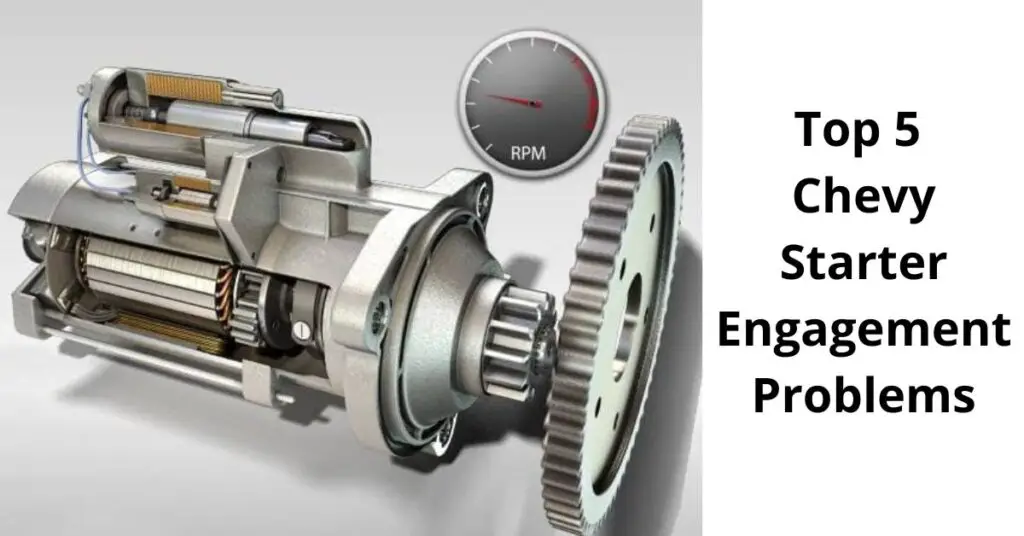I was looking to fix my Chevy starter engagement problems the other day. The problem with my Chevy was that sometimes it starts and runs fine, then after about 20 miles or so, it dies. The battery is not dead, as it is already recharged and the car drives normally for about 15 miles before dying again.
I couldn’t find a proper article on how to fix my Chevy Starter Engagement Problems, so I knew I had to write a definitive guide on it.
What causes Chevy Starter Engagement Problems?
The function of a properly functioning starter motor is to allow the engine to take in fire and air during the ignition process. It achieves this by cranking the engine. The disruption of this process leads to the following Chevy starter engagement problems.
Top 5 Chevy Starter Engagement Problems & their Fixes

These are the top 5 Chevy Starter Engagement Problems and how to fix them:
1. Production Of Smoke When Starting The Engine
This Chevy starter engagement problem is usually caused by a connection issue caused by a faulty ignition switch or a short circuit with the starter motor.
It can also occur when the starter motor is supplied with an excess amount of power. The sign of this problem is the visible appearance of smoke from under the engine.
When the smoke’s appearance progresses to a stage where it is accompanied by a burning smell, it signifies that the starter motor problem is getting serious.
Fix:
- Check the battery voltage capacity. If the battery capacity is low, it could be the potential cause of your smoking starter. Try recharging the battery and checking if the smoking will stop.
- Check the tightness of your wiring connections, as this is one of the major Chevy Starter Engagement Problems.
- Also check for any signs of battery corrosion, oil leakage, dirty connections, and/or diminished parts of the starter and fix them.
- Preferably, replace the starter with a new one.
If you own a Chevy 305 instead, check out this guide on Common Problems with Chevy 305.
2. Starter Motor Gets Oil-Soaked
The proximity between starter motors and the bottom of the engine is the most common cause of Chevy starter engagement problems like this. As a result of the proximity between the two, the Chevy starter is vulnerable to getting covered in oil when an engine leak occurs.
This causes a serious limitation on the starter’s overall performance and its lifespan as well. It also affects the durability and maximum efficiency of the starter.
Fix:
Once this problem is discovered, promptly identify the engine’s leaking spot and fix it. After that, make sure that you replace the starter motor to ensure that the likely occurrence of this Chevy starter engagement problem is limited.
3. The Starter Motor Remains Turned On
Normally, the power released to the starter motor while it is on should be cut off as soon as the off button function is applied. When your starter continues engaging even after being turned off, it’s a sign of a starter problem. This particular Chevy starter engagement problem is caused by a malfunction of the starter solenoid.
The failure of the main contacts (the connector and the positive/negative terminals) within the starter solenoid is the likely cause of this problem. If left unattended, this problem can lead to damage to the entire starting system and the flywheel as well.
Fix:
- While starting the car, ensure that there are no excessive voltage drops in the starter supply and magnetic switch respectively. You can find out the acceptable voltage drop levels from the vehicle service manual.
- Excessive voltage drops can occur as a result of bad connections or damaged cabling. If this is confirmed, consult a qualified technician for the repair or replacement of the bad connections.
- Ensure that the contacts and connections of the ignition switch are firm and solid. All faulty contacts with the ignition and magnetic switches or the starter relay should be replaced.
- To limit potential damage to the starting system and flywheel of your Chevy starter, advice from an experienced auto technician should be sought promptly to solve this issue.
4. Chevy Not Starting Issue
Chevy not Starting Issue is one of the early indicators of a popular Chevy starter engagement problems. The function of the starter relay is to release electrical current to the starter. When the starter relay releases no electrical current, intermittent starting issues begin to occur. This is characterized by the need for a couple of presses on the start button before the engine starts running.
Fix:
- As a Chevy starter engagement problem solely caused by dirty contacts in the starter solenoid and other electric connections, cleaning all the connections, contacts, and all related components should be able to fix it.
- This is a basic preliminary measure that can solve the issue. Don’t forget to seek the help of an experienced auto technician if the problem acts stubborn.
5. Engine Makes a Grinding Noise
Among all the Chevy starter engagement problems, grinding noise is one of the most common. This noise is similar to the one heard whenever you try to restart an engine that has already started.
The grinding noise is produced as a result of the wearing of the drive gear which prevents it from making proper contact with the flywheel.
It can also be caused by a faulty starter solenoid and/or loose mounting bolts on the starter motor. As one of the most common starter motor problems, it is usually one of the most ignored as well.
Unknown to some people, ignoring this issue can result in damage to the engine flywheel.
Fix:
- The wisest, most cost-effective, and longest-lasting method of putting an end to this issue is by replacing the entire engine starter unit. It is as simple as that.
- Alternatively, you can install the new gear and/or replace the solenoid.
Check out the 350 Chevy Engine Diagram which will help you in diagnosing Chevy Starter Engagement Problems.
What Causes a Starter to Not Stay Engaged?
Chevy starter engagement problems don’t occur for no reason. There could be several reasons why your Chevy starter is not engaging. Some of which are;
•Insufficient amount of voltage power in the battery. You can use a voltmeter to easily check the amount of voltage power in your car’s battery.
•Corrosion of the battery terminals.
•Failure of the starter solenoid.
•Malfunction of the starter relay.
•Poor electrical connection can also prevent your starter from engaging.
•Wearing of the driver’s gear.
How to Fix Chevy 350 Starter Not Engaging Flywheel
- If the cause of the Chevy starter problem is low voltage, simply recharging or replacing the battery can remedy the situation.
- Tighten any loose connection between the battery and the starter motor.
- If the problem is from the starter solenoid, it is best to replace it. Alternatively, you can solve the problem of the faulty solenoid by grounding it within the engine compartment with the aid of a jumper wire.
- Worn-out pinion gears should be replaced promptly.
- If you discover that the flywheel is worn out or damaged, ensure that it is replaced with a new one. This will help in rectifying the starter engagement problem.
How Do You Test Chevy’s Starter Engagement?

Follow these steps to test starter engagement on Chevy:
- Locate the starter solenoid.
- Conduct a click test by simply paying attention to detect the production of any clicking sound while someone helps you to turn the ignition switch on.
- Check for a clicking sound. A clicking sound accompanied by an unmoving motor indicates that the solenoid could be engaging but not receiving sufficient battery power. If no sound is produced at all, you might be dealing with a starter solenoid malfunction or a dead car battery.
- Test the battery voltage with a voltmeter. If the reading of the battery is less than 12 Volts or there is no reading at all, the battery may either be low or dead.
- Use a jumper wire to check for current resistance in the control circuit. Simply connect the jumper wire between the control circuit terminal and the terminal of the input solenoid. If a solid clicking sound is not produced, there is a tendency that the starter solenoid is faulty.
- Take an accurate voltage drop measurement from the starter solenoid. A voltage drop of less than a volt indicates a faulty solenoid while an excessive voltage drop likely indicates a faulty electrical connection.
How Do I Know if My Starter Needs Shims?
To know if your starter needs shims, check if your starter is producing loud cranky sounds. If it is, your starter needs shims to prevent or reduce such loud noises emitted by the starter. Also, starters often require shims to separate the drive gear from the tape gear.
Chevy 350 Starter Replacement Guide

Follow this guide to replace your Chevy 350 Starter:
- Disconnect the negative cable of the battery and go through the vehicle repair manual.
- Disconnect the wiring and positive battery cable from the starter solenoid.
- Detach the bolts securing the starter and remove the starter.
- Check the specifications of the starter you are about to install to ensure that it is compatible. This step is a necessary factor you must have considered before purchasing the starter.
- Transfer the heat shield and/or brackets equipped with the new starter.
- Inspect the flywheel teeth for any damage. After that, replace the old starter with the new one. If suitable, attach the shim as well.
- Tighten the bolts reasonably; not too tight or loose either. Remember that loose bolt mounts can prevent the starter from engaging.
- Properly connect the wiring back to the starter solenoid. Also, take precautions to avoid making poor wiring connections because they can prevent the starter from engaging.
- Reconnect the previously disconnected battery and fire up the chevy 350 engine.
Conclusion
We all want our cars to function without fail. Despite this, Chevy Starter Engagement Problems still come knocking inevitably.
I hope that with the help of fixes and solution in this article, you will be able to get your faulty car starter to function properly.
You must send your cars for periodic maintenance. This will help you to prevent engagement problems with your Chevy.

